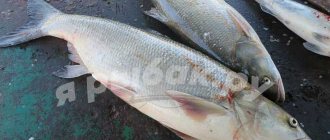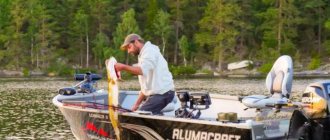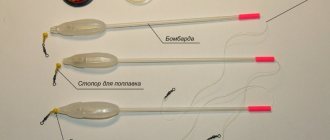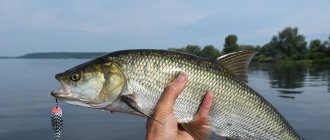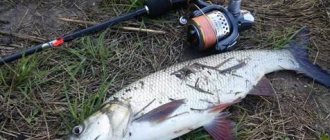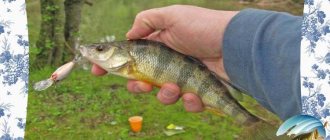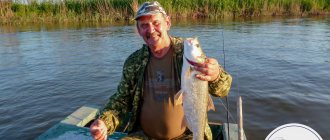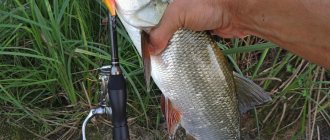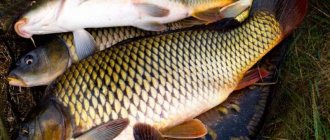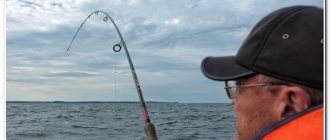The asp is the largest predator in the carp family, called a river corsair among fishermen. Reaching a length of up to 100 cm and a weight of 10 -12 kg, it is a coveted trophy for almost every spinning player - from a beginner to a seasoned professional athlete.
Catching this predator is considered a sign of skill and evokes respect among fishermen - in order to catch this cunning and cautious fish, you need both a considerable amount of knowledge of its habits, as well as practical skills in the selection and correct configuration of gear, the choice of bait, tactics and fishing techniques.
In what places and when to catch asp?
The asp is a typical river predator, living in the middle reaches of lowland rivers.
The predator prefers to hunt in places such as:
- Sand spits and shallows bordering the depths;
- The coastal zone of straight sections of rivers with a medium flow, a hard rocky or turfy bottom and a depth of no more than 2 m;
- Places under trees and bushes hanging over the water;
- Swirls and whirlpools behind bridge pilings;
- Coastal snag;
- Places below riffles (crossing the river bed perpendicularly or at an angle in sediments);
- Behind the spillways of hydraulic structures (hydroelectric power plants, gateways of simple dams).
Note! Closer to the autumn cold, the fish moves after the fry to deep wintering holes remote from the shore, where they remain until freeze-up, hunting on the adjacent shallows and spits.
Fishing time
In most rivers, asp are caught from May to September.
During the day, the predator is most active at the following times:
- At morning and evening dawn, before sunrise and after sunset;
- In the daytime in windy and cloudy weather and constant atmospheric pressure over the previous 2-3 days;
- During the daytime in moderately warm and sunny weather with little wind.
Good to know! In the summer heat, it almost does not hunt during the day and stands in the shade of tree branches, bushes, steep and high banks hanging over the water.
The asp is also passive during cold weather or bad weather - when such weather sets in, the predator most often goes to depth, where it feeds very sluggishly.
Tackle for asp fishing
The most common and productive gear for catching this predatory fish is a spinning rod.
Rod
For asp fishing, light and durable spinning rods of medium or slow action (parabolic or semi-parabolic) with a weight of 10 to 30-35 g are used.
The choice of rod length for asp spinning fishing depends on the fishing conditions:
- On medium and large rivers, the most popular rods will be rods with a length of 270 to 300 cm;
- When fishing from a boat and also for fishing on small rivers, 240 cm blanks are suitable;
For a long casting distance, the rod should also have a comfortable and sufficiently long solid cork handle, a reliable reel seat, and guide rings on high legs.
Let's celebrate! The first passage ring from the butt especially affects the casting distance - it should have a large internal diameter and high and reliable legs.
Coil
To catch this predator using a spinning rod, light and durable spinning reels of size 2500-3000 with a finely adjustable front friction brake, 3-5 bearings (of which 1 must be in the line roller), ideal laying of the fishing line (cord) are used.
Also, such a reel must have a reliable mechanism for fixing the line handle when discarding the line from the spool, preventing it from spontaneously snapping off and shooting the bait when casting.
Line and leashes
For spinning fishing, both monofilament and braided cord of the following diameters are used:
- Monoline – 0.22-0.25 mm;
- Braided cord - 0.12-0.16 mm.
Since the asp does not have teeth on its jaws, metal leashes are not used when catching it. Instead, 30-50 cm leashes made of fluorocarbon fishing line with a thickness of 0.27-0.30 mm are used to disguise the equipment.
In order to reduce the twist of the main line and simplify the process of changing baits, a swivel and a latch are attached to the ends of the leash.
Asp diet
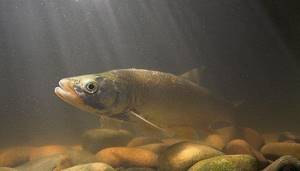
Because the asp has no teeth, his hunt for his prey has some peculiarities. The asp gets its food by stunning its potential prey. It looks like this:
- The asp finds a school of small fish and jumps out of the water, after which it just as quickly falls into the water.
- This impact with the water is enough for some of the fish to freeze in surprise. This moment is enough for the predator to get part of the small fish into the asp’s mouth.
In most cases, the diet consists only of small fish, such as redfish, rudd, sabrefish, etc.
A small asp, not reaching a size of 35 cm, does not yet have the opportunity to hunt small fish; therefore, it feeds mostly on insects, their larvae, worms and crustaceans.
But this applies not only to small individuals, but also to an adult asp, which has weakened at the end of the spawning process or due to a lack of basic food, the fish begins to feed on insects, small frogs and crustaceans.
At the end of spawning, the asp can be easily caught using bottom tackle. But such fishing does not bring pleasure to the angler, because he actually does not resist once he gets hooked. At the end of spawning, the asp becomes very weak. This is partly due to the fact that they engage in duels to compete for the right to fertilize the eggs.
In most cases, this predator hunts both in the middle and upper layers of water, which indicates that it belongs to pelagic ichthyophages.
How to choose bait for asp fishing?
This predator is caught throughout the year using both artificial spinning rods and natural baits of animal origin.
Wobblers
Of the wobblers, the asp is best taken with driven minnows, walkers, poppers of natural colors (silver, white, greenish and black) with a length from 60-65 to 90-110 mm.
Since perch hunt in shallow areas in the surface and subsurface layers of water, surface baits are used: suspenders (wobblers with neutral buoyancy) with a depth of 0.5 to 1.5 m.
The most popular models among zebra spinners are:
- Zip Baits Orbit 65 SP Slider;
- SalmoThrill;
- Zip Baits RIGGE 56;
- Nils Master Haka Shallow;
Jigs
From jigs - narrow and long oscillating spoons - you can catch a river corsair on a model 70-90 mm long and weighing from 10-12 to 25-30 g, both natural (silver, golden, copper) and bright colors (bright red, yellow) .
In this case, the former are used when fishing during the daytime, and the brighter latter are used for fishing early in the morning or late evening in conditions of predawn or evening twilight.
Among these baits, the most commonly used models are:
- Bay De Noc Swedish Pimple;
- RenegadeIronMinnow;
- CastmasterLuhr Jensen CAST CHAMP.
Turntables
To catch asp during the open water season, use back-loaded baits weighing 10-25 g with long lanceolate (“willow”) petals of silver, golden or combined (silver with purple and blue, silver with black shades) colors.
The most popular models for asp fishing among baits of this type are:
- Mepps AGLIA Long HEAVY No. 3;
- Myran Mira 7;
- PANTHER MARTIN ORIGINALE, 9gr.
Vegetable baits
Being a typical predator, the river corsair ignores plant baits.
Animal bait
Among natural baits of animal origin, this predator takes best on the May beetle, grasshopper, and large worm. Less often, river corsairs catch fry.
Best lures
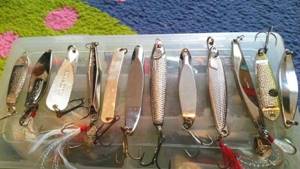
The classic bait for catching asp is a heavy, narrow-bodied spoon. It has high flight characteristics, a characteristic game that imitates small escaping fish, and is capable of working in the upper horizon, in the water column, and at the very bottom.
Jigs that must be included in a gable fisher's kit:
- Kastmaster;
- Hopkins;
- Three-sided;
- Kukri;
- Trophy;
- Renegade Iron Minnow.
In addition to jigs, experienced fishermen hold Devon in high esteem - a unique asp bait designed for long distances. It works on high-speed wires, rotates quickly, creating noise and turbulence in the water flow with its blades, which imitates a small fleeing fish.
At medium and close distances, turntables are relevant. Since fishing is carried out in the current, it is necessary to use weighted rear-loaded spinners with elongated petals. They operate stably in a strong stream when fed at different angles to the flow. The best results are shown in the summer.
Wobblers are also used in asp hunting. When fishing with ultralight and light spinning rods, crankbaits, topwaters and miniature minnows work well. Adult spinning involves fishing with “minnow” class baits 7–12 cm long, endowed with their own low-amplitude action.
Jig baits are relevant in cold water when the sheresper stays near the bottom. Silicone twisters and narrow-bodied vibrating tails 7–10 cm long in white or pearl color are suitable. Foam rubber works well, polyurethane foam fish work a little worse.
Recommended reading: Flies for asp fishing
Peculiarities of asp fishing by season
Spring
In the spring, after warming and the opening of the rivers, the asp begins to migrate to spawning grounds - sections of rivers with a hard rocky or clay bottom and a moderate current. The predator spawns at a water temperature of +6+100C, after which some time later (in mid-May), as the water level in the river normalizes and its thickness clears from turbidity, it begins to actively feed.
They catch it at this time with rotating and oscillating spoons behind the rifts, on sand spits and shallows with a large concentration of fry. In spring, the fish are at their highest activity of the year - the predator hunts not only early in the morning and late evening, but throughout the entire daylight hours.
Summer
In summer, this predator hunts in medium-strong currents behind riffles, on spits and shallows, near bridge piles, behind dams and spillways of hydroelectric power stations.
The predator is most active in the early morning (before dawn) and late evening (from sunset to dusk). During the day, in hot weather, it most often hides under the shadow of tree branches and bushes hanging over the water; gets stuck under snags.
In the summer, asps are caught using various spoons, as well as surface and floating wobblers.
Autumn
As the water in the river cools in the fall, the asp gradually leaves the shallow areas behind the rifts and spits and moves after the small fish closer to the wintering pits.
There he continues to feed right up to the freeze-up, choosing as hunting grounds located next to the hole, but often distant from the shore, sandbanks, spits, and sandy islands (middles).
For asp fishing in the fall, heavy and long-range oscillating and rotating spoons are used.
Winter
In warm winters, asps are caught in small and fast, non-freezing rivers, behind the spillway structures of hydroelectric power stations. Asp are caught in winter using large and medium-sized rotating and oscillating spoons.
Techniques and tactics for catching asp
When fishing for river corsairs using spinning rods, 4 main tactics are used:
- “For a splash” - having arrived at a promising area, the fisherman squats down in a “goose-step” approach to the water’s edge and waits for characteristic splashes, indicating the presence of a predator on this section of the river. After waiting for some time (10-15 minutes), the fisherman notices a pattern of series of bursts indicating the cyclic movement of the asp patrolling its hunting destiny.
After this, the spinner waits for the next splash and makes a targeted cast “in advance” 5-10 m upstream of the place where the predator attacked a school of fry a couple of seconds ago. After landing the bait, without waiting for it to sink to the bottom, he begins to pull it to the shore with a uniform retrieve.
This tactic allows the fisherman not to make a large number of idle casts, but by delivering the bait directly to the asp’s hunting trail, placing it in close proximity to it, thereby provoking an attack.
- “Blindly” - with this tactic, as with the previous one, the angler approaches the promising area as secretly and carefully as possible, waits for splashes and, in their absence, begins casting against the current to the places where the predator is supposed to feed. The interval between casts should be at least 1 minute.
- “Into the wade” - a fisherman in a wade or fishing rubberized overalls carefully descends from the shore and enters the water in a promising area as far as his equipment allows him - usually waist-deep, less often chest-deep (it’s inconvenient to cast). After this, he turns to face upstream and begins to make casts of various distances. This tactic is convenient when fishing in areas with shallow (up to 1 m) depths and constant bottom topography.
- “Floating” - this fishing tactic involves floating on a boat with the current while simultaneously casting bait perpendicular to the movement towards the shore. In this case, the first 5-10 meters of wiring in the coastal strip are the most productive - the rest of the cast line or cord, after passing through a promising area, is reeled out with a reel at high speed.
Let's celebrate! The bite of this predator feels like a tight and heavy blow - it should be followed by a short and sharp hook. You should fish out a river corsair carefully - its lips, like all cyprinids, are very weak, not as strong as those of a pike or perch. When catching large specimens, both from a boat and from the shore, it is better to remove them from the water using a landing net or, in extreme cases, a hook.
Description of the fish
Asp is a beautiful and fast fish. This is the reason why people call this predator differently. Due to its appearance and the whiteness of its scales it is often called sheresper or whiteness, and for its speed of attack - grip and horse.
Asp is highly valued by fishermen. Catching a particularly large specimen is a kind of indicator of high skill in spinning fishing.
Since this fish belongs to the carp family, it has a long, wide and flat body. The head of the asp is elongated, with the lower jaw slightly pushed forward and upward. Despite the fact that the sheresper is a predator, it does not have teeth in its mouth. Their role is played by a bony protrusion on the lower jaw and a notch on the upper lip. This arrangement of the jaws ensures their rigid fixation in the closed state and prevents them from moving.
The teeth of the grip are located inside the throat. They are needed for grinding food.
The body of the fish is covered with small scales that fit very tightly together. The color on the sides is lighter than on the back. In the dorsal fin area, the scales have a dark bluish-gray tint. The belly is almost white.
The fins of the asp are light with dark ends. The tail fin is large, and its lower feather is much larger than the upper one. The lower fins are colored red at their base.
Sheresper is a fairly large fish. The average individual weighs 5 kg. Some fish grow up to 12 kg. In its family, the asp takes an honorable 2nd place, second only to the carp.
Reviews from fishermen
Asp fishing with a spinning rod is the pinnacle of skill that I have been striving for for many years now. I changed several spinning rods, reels, not to mention such consumables as wobblers, spinners and other small things. So far I’ve only persuaded two asps – 1 and 1.5 kg. But these trophies brought a lot of excitement and pleasure. After the first one my hands were shaking. Interesting and very exciting fishing. Grade:
Oleg
I don’t consider myself an experienced gall fisher, but I’ve already gotten my hands on this fish. I fish almost all year round - in winter I move to a couple of micro rivers that do not freeze even in severe frosts. For beginners, of course, I wouldn’t recommend starting your career as a spinning rod with an asp - it’s better to practice on perches and grass beds. But for more experienced colleagues, I definitely advise fishing for a river corsair. Although bereton is not as common as pike, you will get more pleasure from fighting with it than with the usual toothy one.
Grade:
Seryoga
Last year I caught a 1 kg asp on a spoon - it resisted so much that I thought there was at least a three-ruble worth of pike sitting there!!!! While I was fishing, I was tired, but I also had a lot of fun)))) I’ll buy bait for the next season and will look for this assertive and strong river predator. Grade:
Ivan
In my opinion, asp is an excellent object for sports spinning fishing. Very stubborn and strong, it gives the angler a lot of pleasure when fishing. The downside, in my opinion, is its low gastronomic value - the meat, although fatty, is very bony. Grade:
Arkady
I tried to catch asp a year ago - during the season I caught only 3 pieces (two of 1 kg each, and the third - about 2 kg). When I pulled out kilos I thought that this was the weight limit for an asp. And then, at the very end of the season, I picked up a two-seater from a spit - even now, as I remember, my heart begins to pound furiously. The river corsair put up a good fight, but I overcame him!!! In short, the asp justified everything that is written and said about him, and along the way, until the end of my days, I “fell ill” with asp fishing. Grade:
Sava
Note! When fishing for asp, in addition to everything described above, camouflage and caution are also very important - when approaching the shore, experienced asp fishers choose places with tall grass and bushes that hide their silhouette; For fishing from a high bank, areas with trees located behind them are selected, against which it will be difficult for a keen-eyed predator to distinguish the figure of the fisherman.
